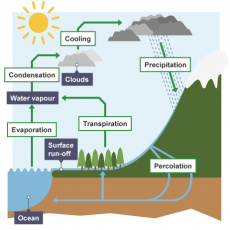

GCSE BIOLOGY REVISION: HOW MATERIALS ARE CYCLED
Please note: Text in bold is what the AQA GCSE biology specification requires an understanding of.
Students should:
recall that many different materials cycle through the abiotic and biotic components of an ecosystem
explain the importance of the carbon and water cycles to living organism
All materials in the living world are recycled to provide the building blocks for future organisms.
Remember, abiotic components are non-living (for example sunlight) and biotic components are living (for example predators.) Atoms occur in diverse forms or compounds at different times in history and cycle between them. We can see this cycling in the element carbon and the compound water. Just as rocks can cycle between igneous, metamorphic and sedimentary, carbon and water can exist in different forms at different times. Additionally, many humans eat meat. Meat contains protein. Our bodies break the proteins down into amino acids. These amino acids are used to make proteins in the body for growth and repair. Once we die, these building blocks are returned to the environment, they are then used by other living organisms.
Here you will need to learn the carbon cycle, it can be a bit daunting at first. Keep going over it and you’ll soon find it easy! The carbon cycle will be explained later, so carry on reading if you wish to find out more.
Students should be able to explain the role of microorganisms in cycling materials through an ecosystem by returning carbon to the atmosphere as carbon dioxide and mineral ions to the soil.
When organisms die, microorganisms come and help out with the decaying process. Components are broken down and then can be used as nutrients for plants. These nutrients are absorbed from the soil into the plant roots. As microorganisms decompose, they also respire and release carbon dioxide (this is part of the carbon cycle, we will cover this in more detail later.)
The water cycle provides fresh water for plants and animals on land before draining into the seas. Water is continuously evaporated and precipitated.
Water has its own cycle, you may have learnt this in your Geography lessons. Water, as you may know, is a key component for life. All organisms need it, some more often than others. The picture shown above demonstrates the water cycle clearly. If you are lucky, you may be asked a question where you can draw out the water cycle. In this case, the picture is the perfect answer. To find out more about each stage, please read on.
Students are not expected to study the nitrogen cycle.
As interesting as it is, you don’t need to know this for AQA GCSE biology. However, if you are planning on taking A level biology, you will have to learn it. So maybe it’s worth a read in your spare time if you want to get ahead!
Key opportunities for skills development
Interpret and explain the processes in diagrams of the carbon cycle, the water cycle.
There are links with the water cycle to GCSE Chemistry 4.9.1.2 The Earth’s early atmosphere.
image- https://www.bbc.com/bitesize/topics/zxfd3k7

0 Comment:
Be the first one to comment on this article.